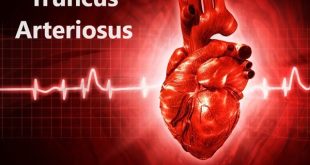Definition
Tay-Sachs disease is a genetic disorder that destroys the nerve cells in the brain and the spinal cord. It is caused by the deficiency of an enzyme hexosaminidase A. Thus it accumulates much fat and lipids called as gangliosides in brain and nerve cells. This leads to loss of function of the nerve cells and causes damage to the central nervous system.
In infants, it occurs in the fetus early in the pregnancy and after two years the baby experiences the seizures and diminishing mental function. The affected children lose motor skills such as sitting, crawling, turning over and children usually die by age five. Tay-Sachs disease can also affect the adults and teens and thus it causes less severe symptoms and also it occurs more rarely.
History
- In 1881 Warren Tay, a British ophthalmologist, observed a “cherry red spot” in the retina of a one-year-old child with mental and physical retardation.
- Later, in 1896 Bernard Sachs, an American neurologist, observed extreme swelling of neurons in autopsy tissue from affected children. He also noted that the disease seemed to run in families of Jewish origin.
- Both physicians were describing the same disease, but it was not until the 1930s that the material causing the cherry-red spot and neuronal swelling was identified as a ganglioside lipid and the disease could be recognized as an “inborn error of metabolism.
- “The term “ganglioside” was coined because of the high abundance of the brain lipid in normal ganglion cells (a type of brain cell).
- In the 1960s, the structure of the Tay-Sachs ganglioside was identified and given the name “GM2 ganglioside”
Epidemiology
- One per 360,000 newborns in the general population is affected.
- One in 280 individuals is a heterozygous unaffected carrier of a HEXA mutation.
- The incidence in French Canadians of the eastern St. Lawrence River Valley area of Quebec is similar to that in persons of Ashkenazi Jewish descent.
- In the Cordoba region of Argentina, among Creole, Spanish, and native peoples, 1 in 26 individuals is a carrier.
- Increased frequencies were reported in Moroccan Jews (1 in 110 is a carrier) as well as in some isolated populations in Switzerland and Japan.
- One in 140 Iraqi Jews is a carrier.
- In Saudi Arabia, the cause is private mutations, which prevents replicating the successful approach used by the Ashkenazi Jewish population. Therefore, alternative solutions must be implemented for other autosomal recessive diseases.
Types
The types of Tay-Sachs disease varies based on the age, individuals, and symptoms that first appear. There are three forms of Tay-Sachs disorder such as follows:
Juvenile Tay-Sachs: This type of Tay-Sachs disease occurs in children leads to decline in their ability to walk, eat on their own and communicate. Sometimes children are prone to respiratory diseases, seizures and pneumonia. A child with first symptoms at age 2 will decline faster than a child with first symptoms at age 5.
Late Onset Tay-Sachs: This type mostly occurs in adults with Late Onset Tay-Sachs slowly decline. This leads to gradual loss of skills. Early symptoms of Late Onset Tay-Sachs (LOTS) include clumsiness and muscle weakness in the legs. Once the adult diagnosed they may experience their childhood such as not being athletic, speech difficulties and/or a stutter as a child or teenager.
Classic infantile Tay-Sachs: this type of Tay-Sachs occurs during the time of birth and thus it typically continues to develop normally for the first six months of age. Around 6 months of age, development slows. Parents may notice a reduction in vision and tracking and the baby does not outgrow normal startle response.
Children’s gradually regress, losing skills one by one. Over time they are unable to crawl, turn over, sit or reach out. Other symptoms include loss of coordination, progressive inability to swallow and difficulty breathing.
Who are at the risk?
Some of the risk factors include such as follows:
- Eastern European (Ashkenazi) Jews at Greater Risk for Tay-Sachs Disease
- A child can only have Tay-Sachs disease if both parents are carriers of the gene
- People of French-Canadian/Cajun heritage and Irish heritage have also been found to have the Tay-Sachs gene.
Causes
Missing enzyme
- The Tay-Sachs disease is mainly caused by the absence or reduced level of an enzyme called beta-hexosaminidase. The gene HexA in the DNA provides instruction for making this enzyme. The accurate amount of Hex A enzyme which is the lipid or fatty substance called GM2 ganglioside accumulates in the nerve cells of the brain. This recurrent accumulation of the substrate causes damage to the cells.
- Typically the infantile Tay-Sachs is due to the absence of HexA enzyme. It differs from other types of Tay-Sachs disease such as juvenile and late-onset Tay-Sachs. When the mutations occur in a gene that allows the hex A enzyme to functionless. Just a small increase in HexA activity is enough to delay the onset and slow the progression of symptoms.
Inheritance and gene location
- The Tay-Sachs disease is also caused due to the defective gene on the chromosome 15 that codes for the production of Hex A. people who have inactive gene along with one copy of the active gene are healthy. They do not have Tay-Sachs disease but they may pass on the faulty gene to their children.
- It is the autosomal recessive genetic disorder. It means both the parents are a carrier for the children to be at risk.
Inheritance of Tay-Sachs disease
Symptoms of Tay-Sachs Disease
- Increased startle reaction
- Irritability
- Decreased eye contact, blindness
- Deafness
- Dementia (loss of brain function)
- Listlessness
- Seizures
- Loss of vision or hearing
- Cherry red spot on macula
- Muscle stiffness
- Decreased muscle tone (loss of muscle strength), loss of motor skills, paralysis
- Slow growth and delayed mental and social skills
- Floppiness and weakness, which keeps getting worse until they’re unable to move (paralysis)
- Difficulty swallowing
Effects of Tay-Sachs Disease
- Spasticity
- Seizures may result in choking or physical injury.
- Infections due to bacteria and viruses.
- Learning disability
- Fits
- Loss of voluntary movements
- Lower motor neuron lesion
- Megencephaly
- Photophobia
- Motor neuron disease
- Short Stature
- Death
Diagnosis and test
Eye examination: TSD can be found during the examination of an eye, which is characterized by a cherry-red spot on the macula. Since this area is composed of photoreceptors which are light-sensing nerve cells.
Enzyme assay: Baseline levels of hexA enzymes can be tested using an enzyme assay test. Reduction of this enzyme from its normal level in the blood indicates the presence of TSD.
DNA testing: DNA test is an absolute way of diagnosing TSD, in order to point out the mutation of HEXA gene. This test may also identify the inheritance pattern of the mutated HEXA gene. Since DNA test is expensive, enzyme assay is mostly preferred as a primary diagnostic option. It is also chosen if a patient is with the family history of TSD.
Amniotic fluid (prenatal) genetic testing: TSD can also be diagnosed during the fetus development using the enzyme assay by needle aspiration of blood samples from the surroundings of a fetus. Diagnosis of TSD can be performed through amniocentesis, in which a sample of amniotic fluid is used for DNA testing. This procedure for the genetic test may pose a risk of miscarriage.
Chorionic villus sampling (CVS): CVS is a prenatal diagnosis procedure, which can detect the genetic disorders in a fetus. Samples are taken from the placental tissue or chorionic villus. This procedure also may develop a risk of miscarriage.
Pre-implantation genetic diagnosis (PGD): It is the latest technique for diagnosing the genetic mutation in the embryos produced by IVF (in vitro fertilization). This test allows parents to implant and carries only the embryos that do not carry the mutated genes that cause TSD.
Management of Tay-Sachs disease
Since TSD is a genetic disorder, there is no cure for, but some treatments and medications can manage the symptoms developed during the onset of TSD. The major goal of treating TSD is to reduce and support the feeling of discomfort.
Medications: It includes anticonvulsants for controlling seizures in children, and antipsychotic drugs for psychiatric disorders in adults. It is important to note that tricyclic antidepressants are thought to be ineffective, and they may actually inhibit the less enzyme activity that may be present in some people with the disease.
Respiratory care: Young children may be at high risk of lung infection and thus require assisted ventilation such as ventilators.
Feeding tubes: Because TSD patients feel difficulty with swallowing, they require feeding tubes. Assistive feeding tube named nasogastric (NG) tube, which delivers nutrients through the nose and esophagus into the stomach. These tubes can be inserted through the abdomen. This percutaneous esophago-gastrostomy (PEG) tubes must be inserted surgically but provide a more permanent feeding solution than NG tubes.
Physical therapy: More neurological and motor functions can get deteriorated in patients with TSD, these patients can do physical therapy to help stimulate the nerves and the muscles. It enhances the muscle function and also maintains the joint flexibility.
Prevention of Tay-Sachs Disease
- Because TSD is a genetic disorder that progressively destroys the central nervous system and so there is no known way to prevent this disease.
- There are chances to get to know about the possibilities of TSD before couples get conceived. They can have a genetic counseling before trying to conceive a baby.
- Pregnant women can be tested for TSD through a genetic test and enzyme assay.
 Diseases Treatments Dictionary This is complete solution to read all diseases treatments Which covers Prevention, Causes, Symptoms, Medical Terms, Drugs, Prescription, Natural Remedies with cures and Treatments. Most of the common diseases were listed in names, split with categories.
Diseases Treatments Dictionary This is complete solution to read all diseases treatments Which covers Prevention, Causes, Symptoms, Medical Terms, Drugs, Prescription, Natural Remedies with cures and Treatments. Most of the common diseases were listed in names, split with categories.







